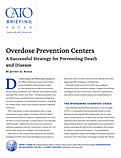As deaths from drug overdoses and drug‐related diseases continue increasing, policymakers in cities across the United States have become more willing to consider implementing overdose prevention centers (OPCs) as the next step toward a more effective harm reduction strategy. For more than 30 years, OPCs have prevented overdose deaths, HIV and hepatitis, and other diseases and helped people with substance use disorder find treatment. OPCs, also known as safe consumption sites or drug consumption rooms, began in Europe in the mid‐1980s. Governments and harm reduction organizations now operate OPCs in 16 developed countries, including many European countries, Canada, Mexico, and Australia. Unfortunately, a federal law that prosecutors and harm reduction opponents call the “crack house” statute makes them illegal in the United States. Yet New York City sanctions two such facilities in defiance of federal law.
Overdose Prevention Centers: The Next Logical Step in Harm Reduction
Related Study
Overdose Prevention Centers: A Successful Strategy for Preventing Death and Disease
Dr. Rahul Gupta, the White House director of the Office of National Drug Control Policy, stated the Biden administration would be “prioritizing harm‐reduction practices because these are proven, cost‐effective and evidence‐based methods that work to save lives.”1 Overdose prevention centers (OPCs) are a successful harm‐reduction strategy that has been saving lives in 16 developed countries—including the United States, where such facilities operate in defiance of the law.

This work is licensed under a Creative Commons Attribution-NonCommercial-ShareAlike 4.0 International License.
